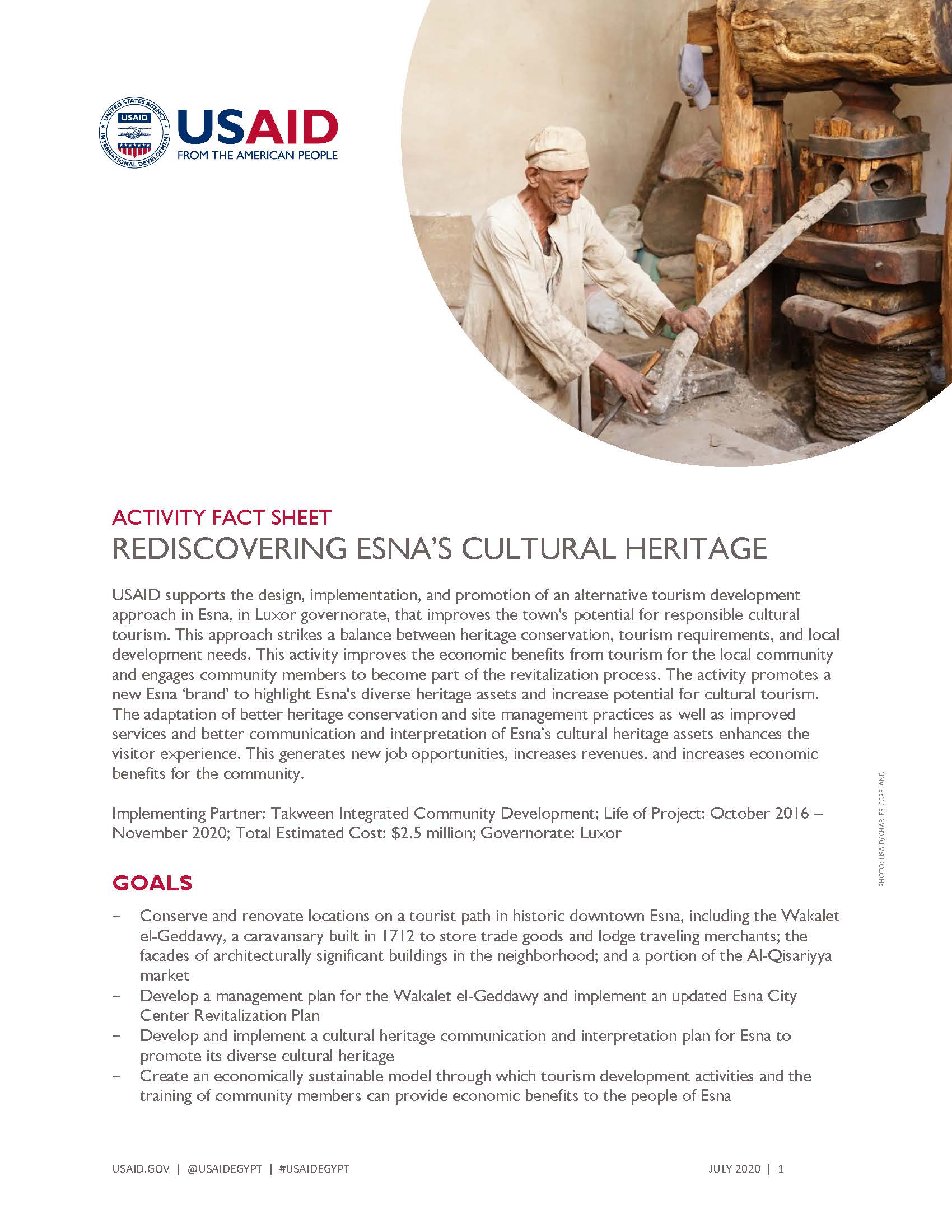Speeches Shim

USAID supports the design, implementation, and promotion of an alternative tourism development approach in Esna, in Luxor governorate, that improves the town's potential for responsible cultural tourism. This approach strikes a balance between heritage conservation, tourism requirements, and local development needs. This activity improves the economic benefits from tourism for the local community and engages community members to become part of the revitalization process. The activity promotes a new Esna ‘brand’ to highlight Esna's diverse heritage assets and increase potential for cultural tourism. The adaptation of better heritage conservation and site management practices as well as improved services and better communication and interpretation of Esna’s cultural heritage assets enhances the visitor experience. This generates new job opportunities, increases revenues, and increases economic benefits for the community.
Implementing Partner: Takween Integrated Community Development; Life of Project: October 2016 – November 2020; Total Estimated Cost: $2.5 million; Governorate: Luxor
GOALS
- Conserve and renovate locations on a tourist path in historic downtown Esna, including the Wakalet el-Geddawy, a caravansary built in 1712 to store trade goods and lodge traveling merchants; the facades of architecturally significant buildings in the neighborhood; and a portion of the Al-Qisariyya market
- Develop a management plan for the Wakalet el-Geddawy and implement an updated Esna City Center Revitalization Plan
- Develop and implement a cultural heritage communication and interpretation plan for Esna to promote its diverse cultural heritage
- Create an economically sustainable model through which tourism development activities and the training of community members can provide economic benefits to the people of Esna
RESULTS
- Completed a conservation plan and drawings to restore an 18th century caravansary. The conservation plan was approved by the Ministry of Antiquities in April 2018, which paved the way for restoration and conservation work to begin
- Completed a needs assessment and intervention plan for the Al-Qisariyya Market through community meetings with market owners and tenants in Esna. Finished upgrades to a portion of the market
- Launched a heritage awareness program for Esna’s public schools to help youth understand ongoing restoration and rehabilitation activities. Raised awareness about the city’s cultural assets to establish a connection between the city’s residents and their cultural heritage – and how that heritage can have economic benefits through increased and improved tourism activities
- Changed the public perception of Esna from only having a temple (Khnum Temple) to a historic city with multilayered history and diverse cultural heritage assets
- Stimulated public and private sector investments in the city and contributions to the activities. In al-Qissariyya Market (114 shops), the Luxor Governorate contributed EGP 187,891 ($11,600) in electrical infrastructure. Twenty-three shopkeepers have invested more than EGP 176,300 ($10,900) to renovate their shops
- Provided job opportunities – more than 18,600 person-days as of September 2019 – for local unskilled labor from Esna in the areas of urban rehabilitation and conservation
- Established a Local Heritage Awareness Program to introduce Esna children and youth to their cultural heritage. The program had 1,915 participants as of October 2019 (1,650 students and 265 teachers from Esna and Luxor)
- Built the capacity of 72 local artisans and craftsmen (68 women and 4 men) in the areas of handicrafts skills (weaving, palm fronds' products, accessories, and woodwork), quality control, and marketing in collaboration with two local NGOs



Comment
Make a general inquiry or suggest an improvement.